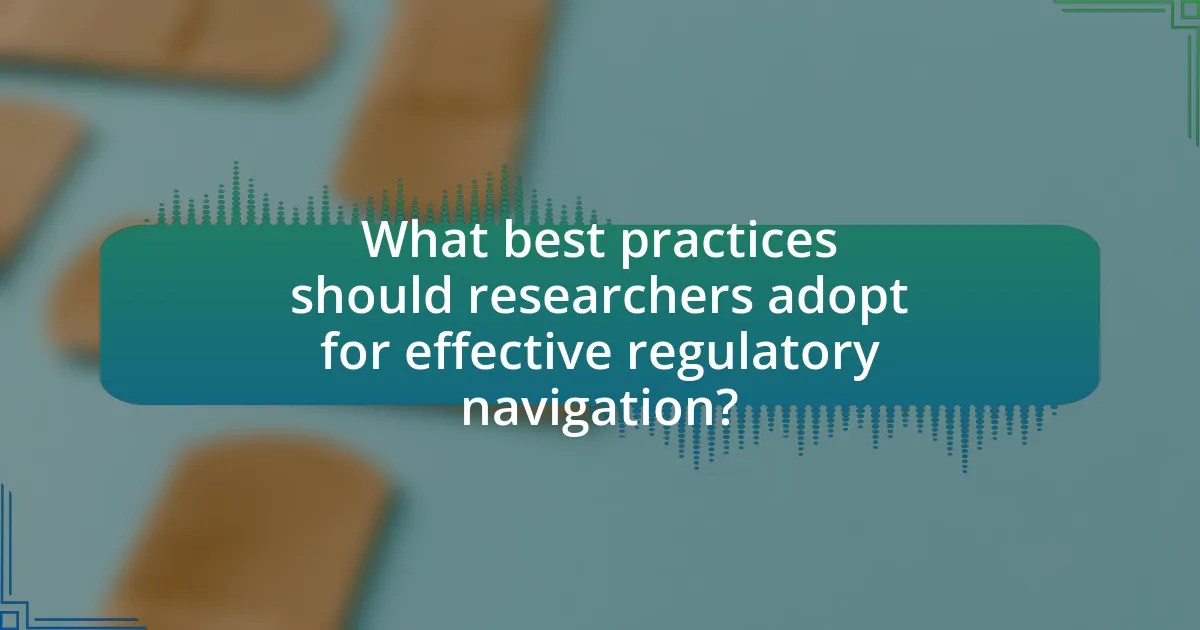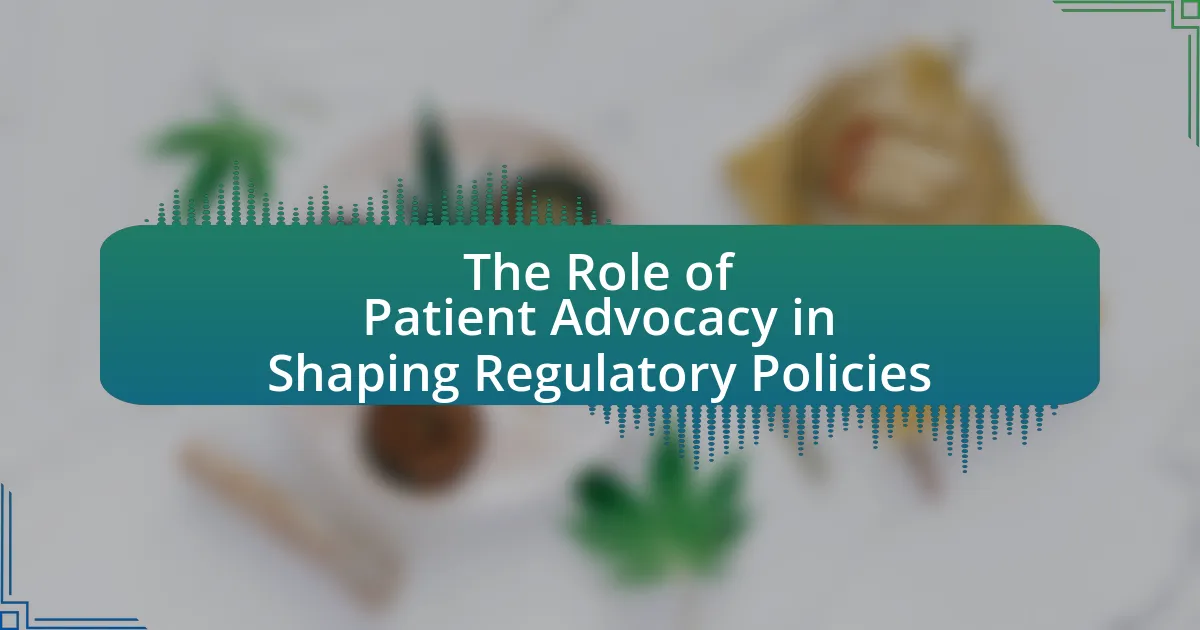The article focuses on strategies for navigating regulatory hurdles in gene editing research, highlighting the key challenges researchers face, including ethical concerns, safety assessments, and compliance with varying laws across regions. It discusses the impact of these regulatory hurdles on research timelines and costs, emphasizing the importance of understanding specific regulations such as those from the NIH and FDA. The article outlines best practices for compliance, including proactive engagement with regulatory bodies, collaboration with legal experts, and the development of comprehensive compliance strategies to mitigate risks associated with non-compliance. Additionally, it provides practical tips for researchers to enhance their success in navigating the complex regulatory landscape of gene editing.

What are the key regulatory hurdles in gene editing research?
The key regulatory hurdles in gene editing research include ethical concerns, safety assessments, and compliance with existing laws. Ethical concerns arise from the potential for unintended consequences and the implications of modifying human genes, leading to debates about the moral acceptability of such interventions. Safety assessments are critical, as researchers must demonstrate that gene editing techniques do not pose risks to human health or the environment, which can delay research approvals. Compliance with existing laws, such as the U.S. National Institutes of Health guidelines and the European Union’s regulations on genetic modification, adds complexity, as researchers must navigate a patchwork of regulations that vary by country and region. These factors collectively create significant barriers to advancing gene editing technologies.
How do these regulatory hurdles impact gene editing projects?
Regulatory hurdles significantly delay gene editing projects by imposing stringent approval processes and compliance requirements. These regulations often require extensive safety and efficacy data, which can prolong research timelines and increase costs. For instance, the U.S. Food and Drug Administration (FDA) mandates rigorous preclinical and clinical trials for gene therapies, leading to delays in bringing innovations to market. Additionally, varying regulations across countries complicate international collaboration, as researchers must navigate different legal frameworks, further hindering progress.
What specific regulations are most challenging for researchers?
The specific regulations most challenging for researchers in gene editing include the National Institutes of Health (NIH) guidelines on recombinant DNA, the Food and Drug Administration (FDA) regulations on gene therapies, and the European Union’s General Data Protection Regulation (GDPR) concerning genetic data. These regulations impose strict requirements for safety, ethical considerations, and data privacy, which can complicate research processes. For instance, the NIH guidelines require extensive review and approval processes for any research involving recombinant DNA, while the FDA mandates rigorous clinical trial protocols for gene therapies to ensure patient safety. Additionally, GDPR enforces stringent rules on the handling of personal genetic information, adding layers of compliance that researchers must navigate.
How do regulatory hurdles vary by region or country?
Regulatory hurdles vary significantly by region or country due to differences in legal frameworks, cultural attitudes towards biotechnology, and levels of governmental oversight. For instance, the United States has a relatively flexible regulatory environment for gene editing, primarily governed by the FDA and USDA, which allows for rapid innovation but requires compliance with safety and efficacy standards. In contrast, the European Union imposes stricter regulations through the European Medicines Agency and the European Food Safety Authority, emphasizing precautionary principles and extensive risk assessments before approving gene editing applications. Additionally, countries like China have rapidly evolving regulations that can facilitate quicker approvals but may lack comprehensive oversight, leading to ethical concerns. These variations are influenced by historical contexts, public opinion, and the prioritization of safety versus innovation in each region.
Why is understanding regulations crucial for gene editing research?
Understanding regulations is crucial for gene editing research because compliance ensures ethical practices and legal protection for researchers. Regulatory frameworks, such as the U.S. National Institutes of Health guidelines and the European Union’s Genetically Modified Organisms Directive, dictate the permissible scope of gene editing, influencing funding opportunities and public acceptance. Adhering to these regulations mitigates risks associated with potential legal liabilities and promotes responsible innovation, ultimately fostering trust in scientific advancements.
What are the potential consequences of non-compliance?
The potential consequences of non-compliance in gene editing research include legal penalties, loss of funding, and damage to reputation. Legal penalties can manifest as fines or sanctions imposed by regulatory bodies, which enforce compliance with established guidelines. Loss of funding occurs when institutions or researchers fail to meet compliance standards, leading to withdrawal of financial support from government or private entities. Additionally, damage to reputation can result from public backlash or loss of trust among stakeholders, which can hinder future research opportunities and collaborations. These consequences underscore the importance of adhering to regulatory frameworks in gene editing research.
How can regulatory knowledge enhance research outcomes?
Regulatory knowledge enhances research outcomes by ensuring compliance with legal and ethical standards, which can expedite the approval process for research projects. Understanding regulations allows researchers to design studies that meet necessary guidelines, reducing the risk of delays or rejections from regulatory bodies. For instance, familiarity with the FDA’s regulations on gene editing can lead to more efficient trial designs that align with safety and efficacy requirements, ultimately facilitating faster access to innovative therapies. This alignment not only improves the likelihood of successful outcomes but also fosters trust among stakeholders, including funding agencies and the public, thereby enhancing the overall impact of the research.

What strategies can researchers employ to navigate regulatory hurdles?
Researchers can employ several strategies to navigate regulatory hurdles effectively. First, they should engage with regulatory agencies early in the research process to understand requirements and expectations, which can streamline compliance. For instance, proactive communication with the U.S. Food and Drug Administration (FDA) can clarify the regulatory pathway for gene editing projects.
Second, researchers can collaborate with legal and regulatory experts to ensure that their research adheres to applicable laws and guidelines, such as the National Institutes of Health (NIH) guidelines for gene editing. This collaboration can help identify potential issues before they arise.
Third, researchers should stay informed about evolving regulations and policies related to gene editing, as these can change rapidly. For example, the European Union’s regulations on genetically modified organisms (GMOs) have undergone significant revisions, impacting research protocols.
Lastly, researchers can participate in public discussions and advocacy efforts to shape regulatory frameworks, ensuring that they reflect scientific advancements and societal needs. Engaging with stakeholders, including ethicists and community representatives, can foster a more supportive regulatory environment.
How can researchers stay informed about regulatory changes?
Researchers can stay informed about regulatory changes by subscribing to relevant government and industry newsletters, attending conferences, and participating in professional organizations. These resources provide timely updates on new regulations and guidelines affecting gene editing research. For instance, the U.S. Food and Drug Administration (FDA) and the National Institutes of Health (NIH) regularly publish updates that are crucial for researchers. Additionally, engaging with peer-reviewed journals and online platforms dedicated to biotechnology can enhance awareness of emerging regulatory trends and compliance requirements.
What resources are available for tracking regulatory updates?
Resources available for tracking regulatory updates include government websites, industry associations, and specialized regulatory tracking services. Government websites, such as the U.S. Food and Drug Administration (FDA) and the European Medicines Agency (EMA), provide official updates on regulations and guidelines relevant to gene editing. Industry associations, like the Biotechnology Innovation Organization (BIO), often publish newsletters and reports that summarize regulatory changes. Additionally, specialized services such as Regulatory Affairs Professionals Society (RAPS) and LexisNexis offer comprehensive databases and alerts for real-time tracking of regulatory developments. These resources ensure that researchers stay informed about the evolving regulatory landscape in gene editing.
How can networking with regulatory bodies aid in compliance?
Networking with regulatory bodies aids in compliance by facilitating direct communication and understanding of regulatory requirements. This interaction allows researchers in gene editing to gain insights into the latest regulations, receive guidance on best practices, and clarify any ambiguities in compliance standards. For instance, organizations that engage with regulatory agencies often benefit from early access to proposed regulations and can influence policy development, ensuring that their research aligns with compliance expectations. This proactive approach not only enhances adherence to legal standards but also minimizes the risk of costly penalties or project delays associated with non-compliance.
What role does collaboration play in overcoming regulatory challenges?
Collaboration plays a crucial role in overcoming regulatory challenges by facilitating knowledge sharing and resource pooling among stakeholders. In the context of gene editing research, collaboration among researchers, regulatory bodies, and industry partners can lead to a more comprehensive understanding of regulatory requirements and best practices. For instance, joint initiatives can help clarify complex regulations, streamline approval processes, and foster innovation while ensuring compliance. Evidence of this can be seen in collaborative frameworks like the International Society for Stem Cell Research, which promotes dialogue between scientists and regulators to address ethical and safety concerns in gene editing. Such partnerships enhance transparency and build trust, ultimately leading to more effective navigation of regulatory landscapes.
How can partnerships with legal experts facilitate compliance?
Partnerships with legal experts facilitate compliance by providing specialized knowledge of regulatory frameworks and legal requirements relevant to gene editing research. Legal experts can interpret complex regulations, ensuring that research practices align with local and international laws, thereby minimizing the risk of non-compliance. For instance, legal professionals can guide researchers through the intricacies of the National Institutes of Health (NIH) guidelines and the Food and Drug Administration (FDA) regulations, which are critical for gene editing projects. Their expertise helps organizations avoid costly legal pitfalls and enhances the credibility of research initiatives by ensuring adherence to ethical standards and legal obligations.
What benefits do interdisciplinary collaborations offer in navigating regulations?
Interdisciplinary collaborations enhance the ability to navigate regulations by integrating diverse expertise and perspectives, which leads to more comprehensive understanding and compliance with complex regulatory frameworks. For instance, collaborations between scientists, legal experts, and ethicists can identify potential regulatory challenges early in the research process, allowing for proactive solutions. Research shows that interdisciplinary teams are more effective in addressing multifaceted issues, as they combine knowledge from various fields, thereby improving the likelihood of meeting regulatory requirements efficiently. This approach not only streamlines the regulatory process but also fosters innovation by ensuring that all relevant factors are considered, ultimately facilitating the advancement of gene editing research within legal boundaries.

What best practices should researchers adopt for effective regulatory navigation?
Researchers should adopt a proactive approach to regulatory navigation by thoroughly understanding the relevant laws and guidelines governing gene editing. This includes familiarizing themselves with the specific regulations set forth by agencies such as the FDA, NIH, and USDA, which oversee gene editing practices in the United States. Additionally, maintaining open communication with regulatory bodies can facilitate smoother processes, as these agencies often provide guidance and clarification on compliance requirements. Engaging with institutional review boards (IRBs) and ethics committees early in the research process ensures that ethical considerations are addressed, which is crucial for regulatory approval. Furthermore, documenting all research activities meticulously aids in demonstrating compliance during audits or reviews. These practices are supported by the increasing complexity of regulatory frameworks, as highlighted in the National Academies of Sciences report, which emphasizes the importance of clear communication and ethical oversight in gene editing research.
How can researchers develop a proactive compliance strategy?
Researchers can develop a proactive compliance strategy by implementing a systematic approach that includes continuous monitoring of regulatory changes, engaging with regulatory bodies, and conducting regular training sessions for staff. This strategy ensures that researchers stay informed about evolving regulations and can adapt their practices accordingly. For instance, the National Institutes of Health (NIH) emphasizes the importance of compliance in gene editing research, highlighting that proactive engagement with regulatory frameworks can mitigate risks and enhance research integrity. By fostering a culture of compliance and accountability, researchers can effectively navigate the complexities of regulatory requirements in gene editing.
What steps should be taken to ensure ongoing regulatory education?
To ensure ongoing regulatory education, organizations should implement a structured training program that includes regular updates on regulatory changes, workshops, and access to relevant resources. This approach allows personnel to stay informed about evolving regulations in gene editing research, which is critical given the rapid advancements in the field. For instance, the U.S. Food and Drug Administration (FDA) frequently updates guidelines that impact gene editing, making it essential for researchers to engage with these changes through continuous education. Additionally, establishing partnerships with regulatory bodies can provide insights and facilitate knowledge sharing, further enhancing the educational framework.
How can researchers create a compliance checklist for their projects?
Researchers can create a compliance checklist for their projects by identifying relevant regulations, guidelines, and ethical standards that apply to their specific field of study. This process involves reviewing federal, state, and institutional policies related to gene editing, such as the National Institutes of Health (NIH) guidelines and the U.S. Department of Agriculture (USDA) regulations. Additionally, researchers should consult with institutional review boards (IRBs) and compliance officers to ensure all necessary approvals are obtained. By systematically documenting these requirements, researchers can develop a comprehensive checklist that includes items such as risk assessments, informed consent procedures, and reporting obligations. This approach ensures adherence to legal and ethical standards, thereby minimizing the risk of non-compliance.
What common pitfalls should researchers avoid in regulatory navigation?
Researchers should avoid the common pitfalls of inadequate understanding of regulatory frameworks, insufficient documentation, and neglecting stakeholder engagement in regulatory navigation. A lack of comprehensive knowledge about the specific regulations governing gene editing can lead to non-compliance, resulting in project delays or legal issues. Furthermore, failing to maintain thorough documentation can hinder the approval process, as regulatory bodies require detailed records of research methodologies and outcomes. Lastly, not engaging with stakeholders, including regulatory agencies and the public, can create mistrust and opposition, which may obstruct research progress. These pitfalls are critical to recognize, as they can significantly impact the success and acceptance of gene editing research initiatives.
What mistakes lead to regulatory delays or failures?
Mistakes that lead to regulatory delays or failures include inadequate documentation, failure to engage with regulatory bodies early, and lack of compliance with established guidelines. Inadequate documentation can result in incomplete submissions, causing review processes to stall. Engaging with regulatory bodies early allows for clarification of requirements and expectations, which can prevent misunderstandings that lead to delays. Additionally, non-compliance with established guidelines, such as those set by the FDA or EMA, can result in rejections or requests for additional information, further prolonging the approval process. These factors collectively contribute to significant setbacks in the regulatory timeline for gene editing research.
How can researchers mitigate risks associated with regulatory non-compliance?
Researchers can mitigate risks associated with regulatory non-compliance by implementing comprehensive compliance programs that include regular training, audits, and updates on regulatory changes. These programs ensure that researchers are well-informed about the latest regulations and best practices, reducing the likelihood of violations. For instance, the National Institutes of Health (NIH) emphasizes the importance of institutional oversight and adherence to guidelines, which can significantly lower the risk of non-compliance. Additionally, establishing clear communication channels with regulatory bodies can facilitate timely guidance and support, further minimizing compliance risks.
What practical tips can enhance success in navigating regulatory hurdles?
To enhance success in navigating regulatory hurdles, researchers should prioritize thorough understanding of relevant regulations and engage with regulatory bodies early in the process. Familiarizing oneself with specific guidelines, such as the National Institutes of Health (NIH) guidelines for gene editing, ensures compliance and reduces the risk of delays. Additionally, establishing open communication with regulatory agencies fosters collaboration and clarifies expectations, which can streamline the approval process. Engaging legal and regulatory experts can provide insights into complex requirements, further facilitating adherence to regulations.




